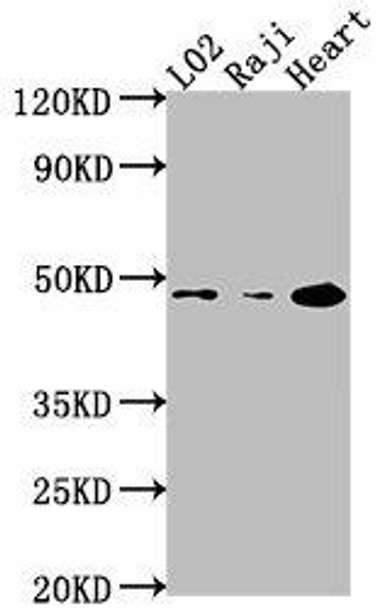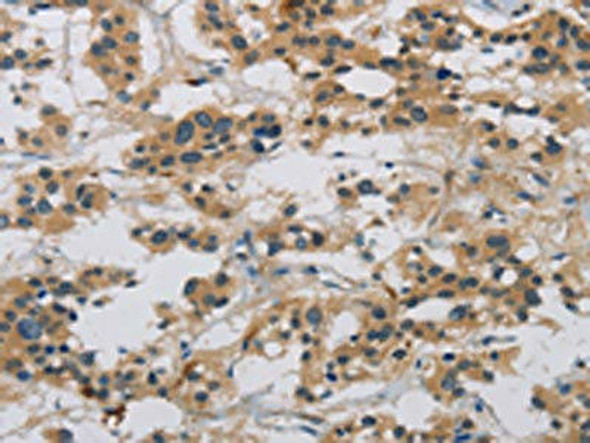CASP9 Antibody (PACO62859)
- SKU:
- PACO62859
- Product type:
- Antibody
- Reactivity:
- Human
- Mouse
- Host Species:
- Rabbit
- Isotype:
- IgG
- Application:
- ELISA
- Application:
- WB
- Application:
- IHC
- Application:
- IF
- Antibody type:
- Polyclonal
- Conjugation:
- Unconjugated
Frequently bought together:
Description
| Antibody Name: | CASP9 Antibody (PACO62859) |
| Antibody SKU: | PACO62859 |
| Size: | 50ul |
| Host Species: | Rabbit |
| Tested Applications: | ELISA, WB, IHC, IF |
| Recommended Dilutions: | ELISA:1:2000-1:10000, WB:1:1000-1:5000, IHC:1:200-1:500, IF:1:50-1:200 |
| Species Reactivity: | Human, Mouse |
| Immunogen: | Recombinant Human Caspase-9 protein (113-324AA) |
| Form: | Liquid |
| Storage Buffer: | Preservative: 0.03% Proclin 300 Constituents: 50% Glycerol, 0.01M PBS, pH 7.4 |
| Purification Method: | >95%, Protein G purified |
| Clonality: | Polyclonal |
| Isotype: | IgG |
| Conjugate: | Non-conjugated |
 | Western Blot. Positive WB detected in: L02 whole cell lysate, Raji whole cell lysate, Mouse heart tissue. All lanes: CASP9 antibody at 1:2000. Secondary. Goat polyclonal to rabbit IgG at 1/50000 dilution. Predicted band size: 47, 31, 18, 37 kDa. Observed band size: 47 kDa. |
 | Immunofluorescence staining of HepG2 cells with PACO62859 at 1:142, counter-stained with DAPI. The cells were fixed in 4% formaldehyde, permeabilized using 0.2% Triton X-100 and blocked in 10% normal Goat Serum. The cells were then incubated with the antibody overnight at 4°C. The secondary antibody was Alexa Fluor 488-congugated AffiniPure Goat Anti-Rabbit IgG(H+L). |
 | IHC image of PACO62859 diluted at 1:285 and staining in paraffin-embedded human heart tissue performed on a Leica BondTM system. After dewaxing and hydration, antigen retrieval was mediated by high pressure in a citrate buffer (pH 6.0). Section was blocked with 10% normal goat serum 30min at RT. Then primary antibody (1% BSA) was incubated at 4°C overnight. The primary is detected by a biotinylated secondary antibody and visualized using an HRP conjugated SP system. |
| Background: | Involved in the activation cascade of caspases responsible for apoptosis execution. Binding of caspase-9 to Apaf-1 leads to activation of the protease which then cleaves and activates caspase-3. Promotes DNA damage-induced apoptosis in a ABL1/c-Abl-dependent manner. Proteolytically cleaves poly(ADP-ribose) polymerase (PARP). |
| Synonyms: | Caspase-9 (CASP-9) (EC 3.4.22.62) (Apoptotic protease Mch-6) (Apoptotic protease-activating factor 3) (APAF-3) (ICE-like apoptotic protease 6) (ICE-LAP6) [Cleaved into: Caspase-9 subunit p35; Caspase-9 subunit p10], CASP9, MCH6 |
| UniProt Protein Function: | CASP9: a member of the cysteine-aspartic acid protease (caspase) family. Sequential activation of caspases plays a central role in the execution-phase of cell apoptosis. Caspases exist as inactive proenzymes which undergo proteolytic processing at conserved aspartic residues to produce 2 subunits, large and small, that dimerize to form the active enzyme. This protein is processed by caspase APAF1; this step is thought to be one of the earliest in the caspase activation cascade. Alternative splicing results in two isoforms. |
| UniProt Protein Details: | Protein type:Apoptosis; EC 3.4.22.62; Protease Chromosomal Location of Human Ortholog: 1p36.21 Cellular Component: apoptosome; cytosol Molecular Function:cysteine-type endopeptidase activity; enzyme activator activity; peptidase activity; protein binding; protein kinase binding; SH3 domain binding Biological Process: apoptosis; caspase activation via cytochrome c; DNA damage response, signal transduction; DNA damage response, signal transduction resulting in induction of apoptosis; platelet formation; response to DNA damage stimulus |
| NCBI Summary: | This gene encodes a member of the cysteine-aspartic acid protease (caspase) family. Sequential activation of caspases plays a central role in the execution-phase of cell apoptosis. Caspases exist as inactive proenzymes which undergo proteolytic processing at conserved aspartic residues to produce two subunits, large and small, that dimerize to form the active enzyme. This protein can undergo autoproteolytic processing and activation by the apoptosome, a protein complex of cytochrome c and the apoptotic peptidase activating factor 1; this step is thought to be one of the earliest in the caspase activation cascade. This protein is thought to play a central role in apoptosis and to be a tumor suppressor. Alternative splicing results in multiple transcript variants. [provided by RefSeq, May 2013] |
| UniProt Code: | P55211 |
| NCBI GenInfo Identifier: | 28558771 |
| NCBI Gene ID: | 842 |
| NCBI Accession: | P55211.3 |
| UniProt Secondary Accession: | P55211,O95348, Q53Y70, Q5JRU9, Q5UGI1, Q92852, Q9BQ62 Q9UEQ3, Q9UIJ8, B4E1A3, |
| UniProt Related Accession: | P55211 |
| Molecular Weight: | |
| NCBI Full Name: | Caspase-9 |
| NCBI Synonym Full Names: | caspase 9 |
| NCBI Official Symbol: | CASP9 |
| NCBI Official Synonym Symbols: | MCH6; APAF3; APAF-3; PPP1R56; ICE-LAP6 |
| NCBI Protein Information: | caspase-9 |
| UniProt Protein Name: | Caspase-9 |
| UniProt Synonym Protein Names: | Apoptotic protease Mch-6; Apoptotic protease-activating factor 3; APAF-3 |
| Protein Family: | Caspase |
| UniProt Gene Name: | CASP9 |
| Secondary Antibody |
| Anti-HRP Goat Anti-Rabbit IgG (H+L) Antibody (CABS014) |
| Recommended Products |
| Anti-FITC Goat Anti-Rabbit IgG (H+L) Antibody (CABS011) |
| Anti-HRP-conjugated Beta Actin Antibody (CABC028) |










